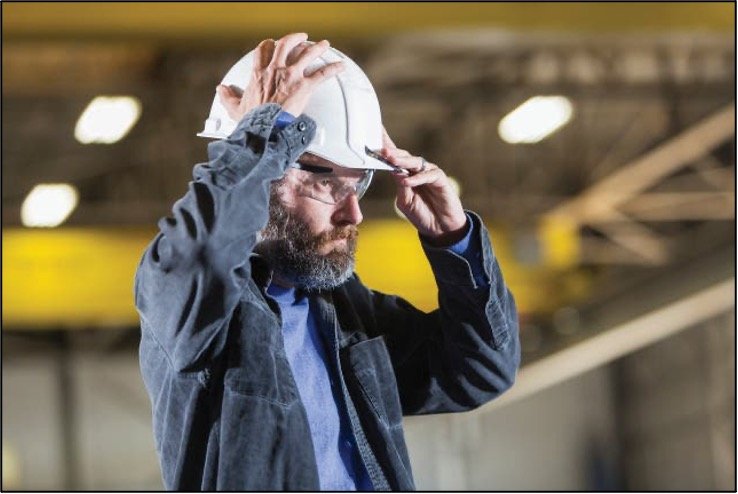Head Protection
Date Posted: 04/24/2023
Hard hats in construction are commonly used to protect workers from a head injury caused by falling objects, striking one’s head against an object, or electrical hazards, including shock and electrocution. The hard hat is a piece of personal protective equipment (PPE) designed to protect a worker when all other protection methods cannot. However, a recent Bureau of Labor Statistics (BLS) survey showed that 84% of workers who suffered impact injuries to the head were not wearing head protection.
When do you Need to Wear a Hardhat in Construction?
Whenever there is a potential for head injury from impact, falling or flying objects, or electrical shock. This means that employers must provide hard hats and ensure that employees wear protective coverings in the following situations:
When objects or debris might fall from above and strike workers on the head.
When employees may strike their heads against fixed objects, like supports, beams, or other equipment.
When there is the possibility that workers’ heads will come into contact with electrical hazards.
According to WAC 296-155-205, “all employees on any construction site must be provided an individual hardhat….”
Function, Types, and Classes of Hardhats in Construction
Hard hats are designed to do two very specific things. First, they are designed to resist penetration. Secondly, they are designed to absorb the shock of an impact. This is accomplished by making the shell of the hat of a material hard enough to resist the blow and utilizing a shock-absorbing lining composed of a headband and crown straps to keep the shell away from the wearer’s skull. If a hard hat is not worn correctly as designed by the manufacturer, such as backward, your level of protection may be compromised. There are two general types of hard hats used in the construction industry. These are:
Inside View of Type 1 Hard Hat
ANSI Type I
They are designed to protect against blows to the top of the head and meet vertical impact and penetration requirements.
ANSI Type II
They are designed to protect against blows to the top and side of the head and meet both vertical and lateral impact and penetration requirements.
In addition to the two classes of hardhats, there are also three classes. These include:
Class E (Electrical)
Electrical hard hats are designed to reduce exposure to high-voltage conductors and offer dielectric protection up to 20,000 volts (phase to ground). However, this amount of voltage protection is designated to the head only and does not indicate voltage protection allocated to the user. Therefore, class E hard hats may also be considered to have a Class G (General) rating, as their increased voltage protection surpasses the (lower) required standards of the Class G testing procedure.
Class G (General)
General hard hats are designed to reduce exposure to low-voltage conductors and offer dielectric protection up to 2,200 volts (phase to ground). As with Class E hard hats, this voltage protection is designated to the head only and does not account for voltage protection allocated to the wearer.
Class C (Conductive)
Conductive hard hats differ from their counterparts because they are not intended to protect against contact with electrical conductors. On the contrary, Class C hard hats may include vented options, which protect the wearer from impact and provide increased breathability through their conductive material (such as aluminum) or added ventilation.
Inspecting Hardhats
Inspect a hard hat when it is new and first placed into use, before each day/shift use, and after any incident when the hard hat’s integrity may be questioned. When inspecting a new hardhat, ensure that it is the proper type and class for the work you will be doing and that all parts are included. Follow all manufacturer’s instructions to assemble and attach parts and adjust the headband tension for a comfortable fit.
When inspecting a hard hat before each day/shift, look for gouges, cracks, deterioration, discoloration, and flaking. DO NOT USE A HARD HAT THAT YOU SUSPECT IS DAMAGED! Instead, replace it immediately with an undamaged hard hat.
Hardhat Lifespan
The safest practice is always to follow the hard hat manufacturer’s replacement guidelines. The most common service life guideline states that hard hat shells need to be replaced after no more than two years of regular use or five years from the date of manufacture—whichever comes first. The life for suspensions is shorter, with replacement needed after no more than twelve months.
To determine the specific replacement date for your hard hat, you’ll need to reference the date of manufacture (usually located on the helmet’s interior). Though the date code may be marked in a variety of ways, it is most common for manufacturers to use a date wheel. These clock-looking codes are universal across all hard hats and safety helmets, with the number in the middle signaling the year of manufacture and the arrow pointing to the number signaling the month.
Resources
Survey of Occupational Injuries and Illnesses Data : U.S. Bureau of Labor Statistics (bls.gov)





